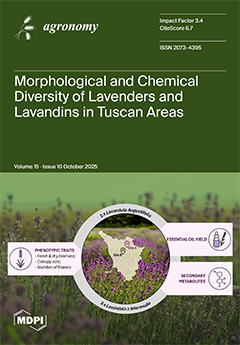Despite the extensive cultivation of Moringa trees in tropical regions, understanding of accession-specific performance across diverse agroecological zones remains inadequate. Thus, this study evaluated the growth, adaptability, and leaf yield performance of 12 Moringa accessions (11
M. oleifera and 1
M. stenopetala)
[...] Read more.
Despite the extensive cultivation of Moringa trees in tropical regions, understanding of accession-specific performance across diverse agroecological zones remains inadequate. Thus, this study evaluated the growth, adaptability, and leaf yield performance of 12 Moringa accessions (11
M. oleifera and 1
M. stenopetala) over three years in a subtropical climate (Pretoria, South Africa). Seeds were planted in seedling trays in the glasshouse at the University of Pretoria’s experimental farm. Vigorous seedlings were transplanted to the field at the Roodeplaat experimental site of the Agricultural Research Council two months after establishment, following a randomized complete block design (RCBD). Data were measured on establishment (emergence, survival), growth and yield parameters, and monitored plant health via leaf greenness, vigour, chlorosis, and pest and disease incidence. Accessions exhibited substantial variation for most traits, except for stem diameter.
Moringa stenopetala showed the highest initial emergence rate but later displayed lower survival rates than most
M. oleifera accessions. Survival rates, morphological features (plant height, canopy diameter, and branching), visual scores for leaf greenness and plant vigour, and leaf yield (fresh and dry) varied considerably among the accessions.
Moringa oleifera A2 consistently performed well, exhibiting vigorous growth, the maximum survival rate (78%), and fresh leaf production (6206 kg ha
−1). Accessions A3 and A8 showed intermediate yield and longevity, indicating potential for cultivation or breeding. Conversely,
M. oleifera A10 and
M. stenopetala markedly underperformed in most traits, limiting their cultivation potential. Based on multi-year performance, A2 is suggested for large-scale cultivation due to its vigour, yield, and stress tolerance, while A3 and A8 hold breeding potential. The study emphasizes the critical role of genetic variation and selection in enhancing Moringa productivity under subtropical environments. Future work should focus on genetic characterization and agronomic practices optimization of superior accessions.
Full article





